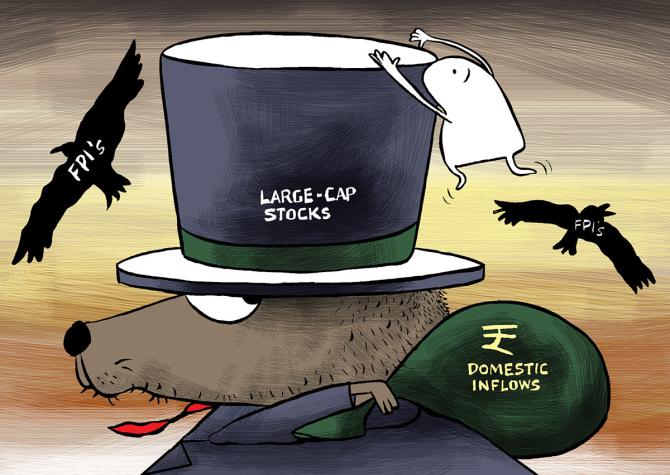'That can be better handled by investing in a staggered manner, ideally through SIPs.'

"Large-caps at this point of time is better over mid and small-caps, which have seen significantly higher pain on the margin and growth fronts," Harsha Upadhyaya, president and chief investment officer - equity, Kotak Mahindra Asset Management Company, tells Abhishek Kumar/Business Standard.
How would you describe the current market situation?
Valuations are in the fair range, assuming that earnings over the next year will be in line with expectations.
However, on a relative basis, they are higher than most other economies and that's one of the reasons for the negative flows from foreign portfolio investors.
This money has been flowing into economies which underperformed last year.
Meanwhile, domestic flows have been robust, providing the necessary cushion to the market.
What would it take for the FPI money to start flowing in again?
Looking from a medium to long-term perspective, India is well positioned to deliver growth, both from the economy and equity market points of view.
The economy has been growing at a fairly resilient pace, despite what's happening on the global front.
On the other hand, markets like China and Taiwan are facing a potential geopolitical risk and are deeply linked to global growth.
So, it's difficult to believe that money is flowing into these economies for the long term.
Considering these factors, India should definitely get better flows in the medium to long term.
What are your market return expectations in the near term, considering the valuations and earnings growth forecast?
The current earnings growth expectation is broadly around mid-teens.
Assuming valuations remain at the same level at the time of investment and exit, the return will be in line with earnings growth.
But valuations keep changing and, hence, it's difficult to predict returns.
How are your portfolios positioned with respect to sectors?
For the last 10-15 months, our focus has been on domestic businesses.
We see sectors with no or limited linkages to the global economy like banking, automobiles, cement, chemicals and industrials to do better than other sectors.
Their valuations are also in the comfortable range.
What are your key takeaways from Q3 results?
The Q3FY23 corporate earnings season has just ended.
It was a muted season notwithstanding the in-line 12 per cent profit growth for Nifty.
The internals of the quarterly earnings were weak, with earnings downgrade outpacing upgrades almost by two times.
More importantly, outside the Nifty 50 companies, the broader market saw weaker profitability than anticipated, implying disappointment from mid and small-cap companies.
If you look sector wise, automobiles and banks have outperformed expectations, while metals, oil and gas (have underperformed.
Expectations from IT were muted and the result was in line with that.
Consumer discretionary also disappointed with lower than expected demand and lower margins.
Which equity funds should investors go for from a five-year perspective?
Equity as an asset class can outperform other asset classes handsomely in the long term.
There will be volatility in the interim and that can be better handled by investing in a staggered manner, ideally through systematic investment plans (SIPs).
In terms of the market cap preference, we prefer large-caps at this point of time over mid and small-caps -- which have seen significantly higher pain on the margin and growth fronts.
Large-cap funds or funds with a large-cap tilt like flexi-cap or large and mid-cap should be preferred.
Disclaimer: This article is meant for information purposes only. This article and information do not constitute a distribution, an endorsement, an investment advice, an offer to buy or sell or the solicitation of an offer to buy or sell any securities/schemes or any other financial products/investment products mentioned in this interview to influence the opinion or behaviour of the investors/recipients.
Any use of the information/any investment and investment related decisions of the investors/recipients are at their sole discretion and risk. Any advice herein is made on a general basis and does not take into account the specific investment objectives of the specific person or group of persons. Opinions expressed herein are subject to change without notice.













 © 2025
© 2025